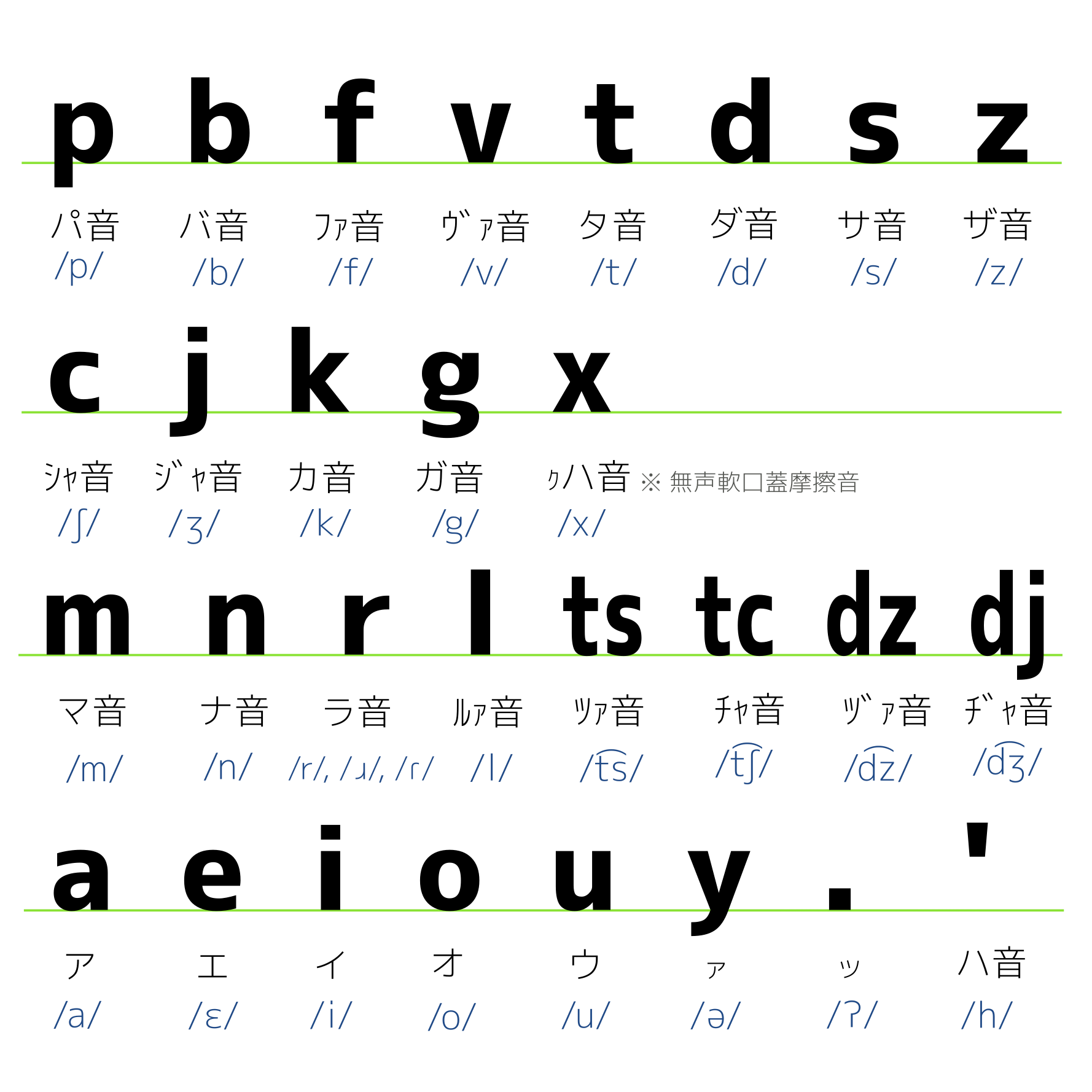2. Pronunciation and alphabet
Pronunciation and letters
![]()
Well, we wouldn’t get anywhere not knowing how to read, so let’s start with pronunciation and the alphabet.
Lojban is generally written with ASCII characters (though there are many alternatives). It’s the digital era, after all.
Below, I’ve listed the pronunciation of the ASCII letters Lojban uses.

![]()
Hmm. Seems you can read many of them like in English. Though, {g} is always hard, and {j} is just the “zh” sound in “measure”… Also, H and Q and W aren’t used, but all the other letters are.
It seems the ones to pay extra attention to are c (sh), x (kh) and y (uh), right? How exactly is x pronounced?
![]()
x is the “voiceless velar fricative”. It’s somewhere between “k” and “h”. You can hear it pronounced here.
![]()
(Fri-ca-wha…? ) I’ll remember to give it a listen before I go to bed. How about… y?
![]()
That one’s the neutral vowel, also known as schwa. It’s that “uh…” sound you make when you’re really exhausted.
![]()
I see. How should I read the letters individually? “Ay, bee, see, dee?”
![]()
The consonants are read as {consonant + y + .}, and the vowels are {. + vowel + bu}.
- “a”
- .abu
- “o”
- .obu
- “b”
- by.
- ”s”
- sy.
- “n”
- ny.
The period represents no sound. It’s a tiny pause or “glottal stop”. Take note that it doesn’t signify the end of a sentence in Lojban (more on this later). The periods at the start of end of alphabet words here keep them from sticking together. まあオマジナイみたいなものだよ。
Oh, similarly, apostrophes only occur between vowels. So you’ll never see “k’a” or “d’e” or something. Apostrophes represent a “h” sound, but Lojban doesn’t count it as a consonant, so it’s a little bit special.
![]()
Gotcha. I see {ts} and {tc} are pronounced like “ts” and “tsh”, so I guess they’re not exceptional!
![]()
Right! And of course the voiced counterparts of those sounds are written as {dz} and {dj}.
Semivowels and diphthongs
![]()
That picture from earlier explains most of what there is to know about pronunciation, but there’s a little more to reading vowels that occur in succession.
- {i} + vowel = (the “y” in “yes” or “you”) + vowel.
- {u} + vowel = (“w” sound) + vowel.
That is to say, {i} and {u} occuring next to other vowels are pronounced as semivowels or glides.
![]()
So, {ies} would sound like “yes”.
![]()
Right. Next, there’s diphthongs:
- {au} = like the “ow” in “how”.
- {ei}, {ai}, {oi} = like the vowels in “bay”, “bye”, “boy”.
So these combinations are read as one syllable.
![]()
So stuff like “ao” and “ea” aren’t valid diphthongs?
![]()
That’s right. For reasons of simplicity, in Lojban, only those four diphtongs are used.
Whenever {a}, {e}, or {o} would follow a vowel, a glide {i} or {u} or apostrophe {‘} is inserted between them.
![]()
Okay, I see!
![]()
Okay, pop quiz! Try to read the following sentences!
- Try to read the following Lojban sentences.
- coi ro do mi’e .soran. co’o .kocon.
- Hello, everyone. My name is Sora. Goodbye, Koshon.
- mi prami do .isemu’ibo dunda lo melbi xrula
- I love you. For that reason, I give you a pretty flower.
- .o’i mu xagji sofybakni cu zvati le purdi
- Watch out, there are five hungry Soviet-cows in that garden.
- coi ro do mi’e .soran. co’o .kocon.
![]()
Um, let’s see…
- Shoy roh doh, mee-heh… soh-ran… sho-hoh… ko-shon.
- Mee prah-mee doh …ee seh-mooheeboh doonda loh melbee khroola.
- Ohee moo khagzhee sof-uh-bahknee shoo zvahtee leh poordee.
Or something!
・・・・・
![]()
What the heck is a Soviet-cow?
![]()
That third sentence is actually a famous pangram. See how it contains every letter?
![]()
Whoa, you’re right!
![]()
Yup! I tried to think of one too, because it’s fun. Mine contains all the diphthongs, glides, and affricates ({ts}, {tc}, {dz}, {dj}) as well. Check it out!
- .ua ja’o le mu tsali dzena cu djicai lo nu re xagji sofybakni cu zvati tu noi tcadu vau .iepei
-
Oh, so the five strong elders desperately wish for two hungry Soviet-cows to be in that town over there, right?
-
![]()
Yikes, that’s long.
Here is Koshon's pangram written in IPA, under the recommended pronunciation rules.
.ua ja'o le mu tsali dzena cu djicai lo nu re xagji sofybakni cu zvati tu noi tcadu vau .iepei
ʔwa ʒaho lɛ mu t͡sali d͡zɛna ʃu d͡ʒiʃaj lo nu ɹɛ xagʒi sofəbakni ʃu zvati tu noj t͡ʃadu vaw ʔjɛpɛj
True/False Questions
- The letter {p}'s name is {pa} in Lojban.
- The letter {e}'s name is {.ebu} in Lojban.
- The letter {y} represents the sound of the "y" in "you".
-/- answers correct!